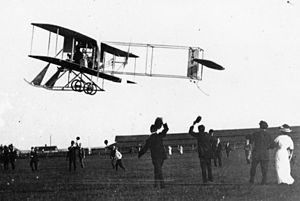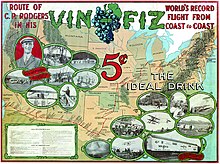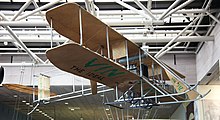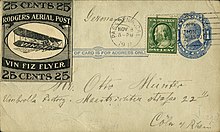| Vin Fiz Flyer | |
|---|---|
 The Vin Fiz Flyer starts its cross-country trip from the Sheepshead Bay Race Track in Brooklyn, N.Y. The Vin Fiz Flyer starts its cross-country trip from the Sheepshead Bay Race Track in Brooklyn, N.Y. | |
| General information | |
| Type | Biplane |
| National origin | United States |
| Manufacturer | Wright Company |
| Status | On display |
| Number built | 2 (also one owned by Howard W. Gill) |
| History | |
| First flight | 1911 |
| Developed from | Wright Model EX |
The Vin Fiz Flyer is an early Wright Brothers Model EX pusher biplane that in 1911 became the first aircraft to fly coast-to-coast across the U.S., a journey that took almost three months.
History
The publisher William Randolph Hearst had offered a US$50,000 prize to the first aviator to fly coast to coast, in either direction, in less than 30 days from start to finish.
Calbraith Perry Rodgers, grandnephew of naval hero Oliver Hazard Perry and an avid yachtsman and motorcycle racer, had taken about 90 minutes of instruction from Orville Wright in June 1911 before soloing, and had won an $11,000 air endurance prize in a contest in August. Rodgers became the first private citizen to buy a Wright airplane, a Wright Model B modified and called the Model EX. The plane's 35 horsepower (26 kilowatt) engine allowed a speed of 50 miles per hour (80 km/h) at 1,000 feet (300 meters).

Since the airplane would need a considerable support crew, Rodgers persuaded J. Ogden Armour, of meatpacking fame, to sponsor the attempt, and in return named the plane after Armour's new grape soft drink Vin Fiz. The support team rode on a three-car train called the Vin Fiz Special, and included Charlie Taylor, the Wright brothers' bicycle shop and aircraft mechanic, who built their first and later engines and knew every detail of Wright airplane construction; Rodgers' wife Mabel; his mother; reporters; and employees of Armour and Vin Fiz.
The flight began at 4:30 pm, September 17, 1911, when Rodgers took off from the Sheepshead Bay Race Track in Brooklyn, New York. Although the plan called for a large number of stops along the way, in the end there were 75, including 16 crashes, and Rodgers was injured several times. Taylor and the team of mechanics rebuilt the Vin Fiz Flyer when necessary, and only a few pieces of the original plane actually made the entire trip.
On November 5, having missed the prize deadline by 19 days, Rodgers landed in Pasadena, California, in front of a crowd of 20,000. On the 12th he took off for Long Beach, California, but crashed at Compton, with a brain concussion and a spinal twist. He was hospitalized for three weeks. Finally, on December 10 he landed on the beach, and taxied the Flyer into the Pacific Ocean, completing the unprecedented journey of over 4,000 statute miles (6,400 km). Actual flying time totalled under 84 hours. Rodgers was killed in an air crash on the Pacific shore of the US shortly after the flight across the US.
The aircraft was acquired by the Smithsonian Institution in 1934, and eventually joined the collection of the National Air and Space Museum, after being fully restored for display by the Smithsonian in 1960. As of August 2009, the plane was still on display at the NASM but was undergoing further conservation.
In 1961, to commemorate the 50th anniversary of the first trans-continental flight, aviation historian and Boeing aeronautical engineer Peter M. Bowers built a reproduction of the Vin Fiz. Built to airworthy standards, the plane was flown as a towed glider, and subsequently became a display in the San Diego Air and Space Museum, where it remains (as of 2022).
In 1986 the Vin Fiz Flyer flight was re-enacted in a replica to celebrate the 75th anniversary of the original journey. The pilot was materials scientist Jim Lloyd.


In addition to the Vin Fiz endorsement, Mabel Rodgers used the flight to promote an airmail service, and sold special 25-cent postage stamps for items to be carried on the airplane. They were semi-official - the Post Office tolerated them, but insisted that mail carry regular stamps as well. The stamps were large, inscribed "RODGERS AERIAL POST" and "VIN FIZ FLYER", with a picture of the airplane in the center. It is believed that they were ordered by Cal's brother, Robert S. Rodgers, from a printer in Kansas City, Missouri, and they were probably first available around October 14.
Twelve Vin Fiz Flyer stamps are known to exist today - seven on postcards, one on a cover, and four individuals. One of the cards sold in 1999 for $88,000. Another one of the cards was only recently discovered; it was bought at an Internet auction for several hundred dollars, then auctioned by Siegel in December 2001 for $44,000.
Shreves Philatelic Galleries, Inc. held a specialized auction "The Pioneers Of Flight Collection" on Nov. 29, 2006 selling four stamps: the only one on cover for $70,000 and three on postcards (for $60,000, $60,000 and $47,500).
Specifications (Vin Fiz Flyer)
Data from NASA
General characteristics
- Crew: 1
- Length: 21 ft (6.4 m)
- Wingspan: 32 ft (9.8 m)
- Height: 7 ft (2.1 m)
- Gross weight: 903 lb (410 kg)
- Powerplant: 1 × Wright Aero Four cylinder four cycle, 35 hp (26 kW)
- Propellers: 2-bladed
Performance
- Cruise speed: 44 kn (51 mph, 82 km/h) average groundspeed
Notes
- "Vin Fiz". www.aerofiles.com. Retrieved 2018-08-14.
- ^ "First flight across nation little noted. 84-day trip ended 60 years ago after 16 wrecks along the way. Toledo Blade, Section A, page 43, Associated Press story, December 12, 1971. Retrieved January 7, 2011
- Airfield named for aviation pioneer'" Pittsburgh Post-Gazette, January 3, 2001. Retrieved January 7, 2011
- "Vin Fiz Flies in the Museum’s Rotunda," San Diego Air & Space Museum, retrieved July 10, 2022
- The Flight of the Vin Fiz Terrell County, Texas, Memorial Museum. Retrieved September 27, 2012.
- Shreves Philatelic Galleries
References
- Eileen F. Lebow, Cal Rodgers and the Vin Fiz: the First Transcontinental Flight. (Washington, D.C.: Smithsonian Institution Press, 1989)
- E.P. Stein, Flight of the Vin Fiz (New York: Arbor House, 1985)
- Richard L Taylor, The First Flight Across the United States: the Story of Calbraith Perry Rodgers and His Airplane, the Vin Fiz (New York: F. Watts, 1993)
- "New 'Vin Fiz Flyer' card found and auctioned", Linn's Stamp News January 14, 2002, p. 14
External links
- Centennial Of Flight account
- The National Air & Space Museum's page on the Vin Fiz
- Archived Page On Old Rhinebeck Aerodrome's Static Vin Fiz Flyer Reproduction
- Adobe PDF File "Transcontinental With The Vin Fiz" By Robert Waldvogel
- Linn's Stamp News August 19, 2019
- Cynthia P. Bayne Calbraith Perry Rodgers Vin Fiz Collection at The Museum of Flight Digital Collections